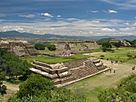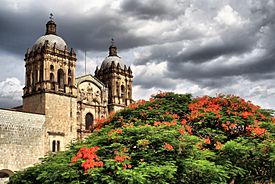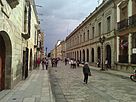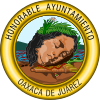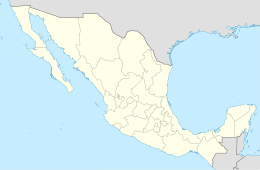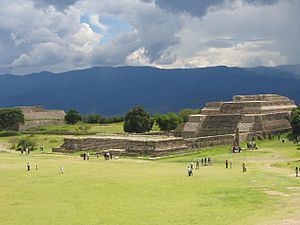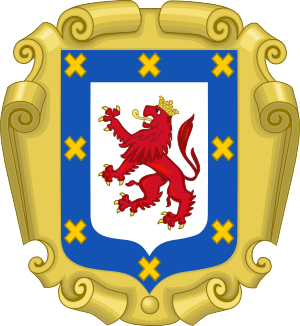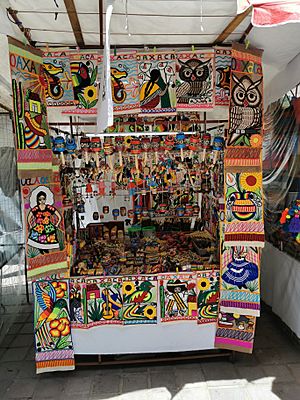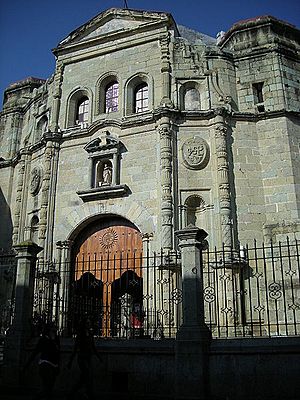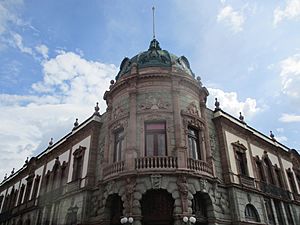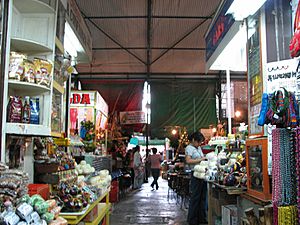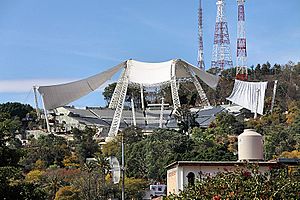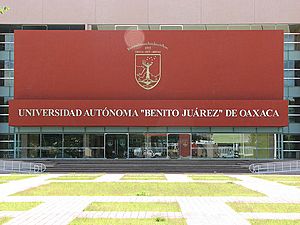Oaxaca City facts for kids
Quick facts for kids
Oaxaca
Ndua (Zapotec)
|
||
|---|---|---|
|
City
|
||
| Oaxaca de Juárez | ||
|
View of Monte Albán, Macedonio Alcalá Theater, Temple of the Ex-Convent of Santo Domingo, Colonial Oaxaca, Zocalo in Oaxaca and view of the Zocalo.
|
||
|
||
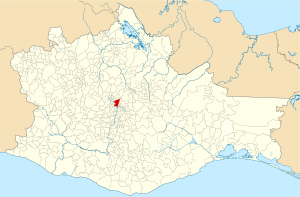
Location of the municipality within Oaxaca
|
||
| Country | Mexico | |
| State | Oaxaca | |
| Founded | 1532 | |
| Municipal Status | 1879 | |
| Named for | "Oaxaca" is a hispanicization of the Nahuatl place name "Huaxyacac" "de Juárez" was added in honor of Benito Juárez |
|
| Area | ||
| • City | 85.48 km2 (33.00 sq mi) | |
| Elevation
of seat
|
1,555 m (5,102 ft) | |
| Population
(2021) Municipality
|
||
| • City | 715,000 | |
| Metro area GDP (PPP, constant 2015 values) | ||
| • Year | 2023 | |
| • Total | $11.7 billion | |
| • Per capita | $15,900 | |
| Time zone | UTC−6 (CST) | |
| Postal code (of seat) |
68000
|
|
| Area code(s) | 951 | |
| Official name: Historic Centre of Oaxaca and Archaeological Site of Monte Albán | ||
| Type: | Cultural | |
| Criteria: | i, ii, iii, iv | |
| Designated: | 1987 (11th session) | |
| Reference #: | 415o | |
| Region: | Latin America and the Caribbean | |
Oaxaca de Juárez, often called simply Oaxaca, is the capital city of the Mexican state of Oaxaca. Its name in the Valley Zapotec language is Ndua. The city is located in the Central Valleys region, nestled in the foothills of the Sierra Madre mountains. It stretches down to the Atoyac River.
Oaxaca is a popular place for visitors, especially because of its many old buildings from the colonial era. It also has important ancient sites and a vibrant culture from the Zapotec and Mixtec peoples. In 1987, the city and the nearby ancient site of Monte Albán were named a UNESCO World Heritage Site. Every year, Oaxaca hosts a month-long cultural festival called the "Guelaguetza". This festival showcases Oaxacan dances, music, and a beauty pageant for indigenous women.
The city is also known as la Verde Antequera, which means "the green Antequera." This name comes from its old Spanish name, Nueva Antequera, and the many buildings made from a local green stone. The name Oaxaca comes from the Nahuatl word Huaxyacac, meaning "among the huaje trees." In 1872, "de Juárez" was added to honor Benito Juárez. He was a famous president of Mexico from Oaxaca who led the country through tough times, including an invasion by France. The city's coat of arms features Donají, a Zapotec woman who was killed during a conflict after the Spanish conquest.
Contents
- Discovering Oaxaca's Past: A Journey Through History
- Oaxaca's Geography and Climate
- Oaxaca's Economy and Tourism
- Exploring Oaxaca: Famous Places to Visit
- Oaxaca's Lively Festivals and Traditions
- Delicious Food and Drink in Oaxaca
- Famous People from Oaxaca
- Education in Oaxaca
- Getting Around: Transportation in Oaxaca
- Surrounding Towns: Craft and Culture
- Oaxaca Municipality: The Larger Area
- Sister Cities of Oaxaca
- See also
Discovering Oaxaca's Past: A Journey Through History
Ancient Beginnings: Early Settlements in Oaxaca
For thousands of years, the Zapotec and Mixtec people lived in the valley of Oaxaca. They built important ancient cities like Monte Albán and Mitla. The modern city of Oaxaca grew up quite close to these old centers. Around 1440, the Aztecs arrived in the valley. They called the area "Huaxyacac," which means "among the huaje trees" in Nahuatl. The Aztecs set up a military base on a large hill called Cerro del Fortín. This helped them watch over the Zapotec capital of Zaachila and protect trade routes.
When the Spanish arrived in 1521, the Zapotec and Mixtec people were fighting. The Spanish conquest stopped these wars. Spanish Catholic missionaries also began to teach the local people about Christianity.
Colonial Times: How Oaxaca Became a City
The first Spanish group came to Oaxaca in late 1521. Captain Francisco de Orozco led them, along with 400 Aztec warriors. Hernán Cortés sent Orozco to Oaxaca because Moctezuma II had mentioned that Aztec gold came from there. Orozco's group started building a Spanish city where the Aztec military post used to be.
The first Christian mass in Oaxaca was held by Chaplain Juan Díaz. It took place by the Atoyac River under a large huaje tree. Later, the Church of San Juan de Dios was built there. This chaplain also gave saints' names to the nearby villages, keeping their original Nahuatl names too. In 1522, the Spanish settlers chose their first mayor and town council. They also began building the cathedral of Oaxaca. They called their new settlement Guajaca, which was a Spanish version of the Aztec name.
Hernán Cortés, who wanted to control the whole region, didn't like this independent village. He sent Pedro de Alvarado, who forced most of the people out. The original Spanish settlers asked the Spanish king to recognize their village. The king agreed in 1526 and divided the land among Orozco's expedition members. But three months later, Cortés again forced out the people and put his own people on the town council. The original founders appealed to the Spanish viceroy in Mexico City, Nuño de Guzmán. He supported the original founders, and they re-established the town in 1529. They named it Antequera, after Nuño de Guzmán's hometown.
Meanwhile, Cortés received the title of Marquis of the Valley of Oaxaca from the king. This meant he could demand high taxes and control the land around the village. The village of Antequera had to survive while surrounded by other villages that obeyed Cortés. These villages were often unfriendly, likely encouraged by Cortés.
To protect itself, the village asked the king to make it a city. This would give it special rights and keep it under the king's direct control, not Cortés'. King Charles V of Spain granted this request in 1532.
Mexico's Independence and Modern Times
After Mexico became independent in 1821, the city became the center of a municipality. Both the city and the municipality changed their name from Antequera to Oaxaca. In 1872, "de Juárez" was added to honor Benito Juárez. He was born in Oaxaca and became a lawyer and politician there. He served as president of Mexico from 1858 until his death in 1872.
In 2006, there were big protests in Oaxaca. These started because the state governor banned political demonstrations in the main square, called the zócalo. He wanted to make the Zócalo a modern tourist spot. In May 2006, the teachers' union held their yearly protest in the Zócalo. This year, more teachers joined due to growing unhappiness with the governor.
The government offered teachers more money, but some felt it wasn't enough. On June 14, the police attacked the teachers in the Zócalo. This made many people angry at the governor. Many groups joined the teachers to form the Popular Assembly of the People of Oaxaca (APPO). This group stood up for people's rights and even took over some government buildings. They also replaced the city's police with a civilian force based on local traditions.
In October 2006, Mexico's president sent in more than 10,000 police and soldiers to take back control. There were clashes, and some people died. By late December, the teachers' strike ended. The city slowly returned to normal.
Oaxaca's Geography and Climate
Oaxaca's Climate: Warm Days and Cool Nights
Oaxaca has a tropical savanna climate. This means it has warm days and cooler nights, especially in the dry season. The coolest month is December, with an average high of 27.1°C (80.8°F). April is the warmest, reaching about 33.3°C (91.9°F) before the rainy season starts. Even though it's warm during the day, nights can be cool, with January lows around 9°C (48°F). Because Oaxaca is high up, about 1555 meters (5000 feet) above sea level, its climate is cooler than other places at the same latitude. Most of the rain falls in the summer months, with June being the wettest.
Oaxaca's Economy and Tourism
Tourism is very important to Oaxaca's economy. The city attracts visitors with its beautiful landscapes and charming old buildings. About 77% of jobs in Oaxaca are connected to tourism. The city center, with its many historic buildings, is a World Heritage Site recognized by UNESCO.
Tourists visit Oaxaca most often during three times of the year:
- Holy Week (around Easter)
- Summer (especially during the Guelaguetza festival)
- New Year
Many Mexican visitors come during Holy Week and New Year, often returning to visit family. Most international tourists come in the summer. After tourism, the next biggest parts of Oaxaca's economy are mining and manufacturing.
Exploring Oaxaca: Famous Places to Visit
Plaza de la Constitución (Zócalo): The Heart of the City
The Plaza de la Constitución, or Zócalo, was designed in 1529. For a long time, it was just a dirt plaza with a marble fountain. Over the years, it was updated with trees, a statue of Benito Juárez, and a new Art Nouveau bandstand. Today, the bandstand often hosts the State Musical Band and other groups.
The Zócalo is surrounded by covered walkways called arcades.
- On the south side, you'll find the Portales de Ex-Palacio de Gobierno. This used to be the government palace but is now a museum called "Museo del Palacio 'Espacio de Diversidad'".
- Other arcades include the "Portal de Mercadores" on the east, "Portal de Claverias" on the north, and the "Portal del Señor" on the west.
The State Government Palace is on the main square. The current building was started in 1832 and finished in 1887. Inside, you can see murals painted by Arturo García Bustos in the 1980s. These murals show Oaxaca's history from ancient times to after Mexico's independence.
Across from the cathedral is the Federal Palace. Its design is "neo-Mixtec," meaning it copies elements from ancient sites like Mitla and Monte Albán. This style was popular in the early 1900s to show pride in Mexico's ancient cultures.
Northwest of the Zócalo is the Alameda de León, a lovely garden area. It was created in the 1840s by Antonio de León, the governor of Oaxaca. It's like a smaller version of the Alameda Central in Mexico City. A statue of León was added here in 1885. {{wide image|Alameda de León Oaxaca Mexico.jpg|880px|The beautiful Alameda de León plaza in Oaxaca.]]
Andador Macedonio Alcalá: A Pedestrian Street
The Macedonio Alcalá Tourist Corridor is a street paved with green stone. It was closed to cars in 1985 and is now only for people walking. Along this street, you can find important places like:
- The original building of the Universidad Autónoma Benito Juárez.
- The Museo de Arte Contemporáneo (Museum of Contemporary Art) or MACO.
- The Plazuela (small plaza) Labastida.
- The Parroquia de la Preciosa Sangre de Cristo (Parish of the Precious Blood of Christ).
Churches and Historic Religious Buildings
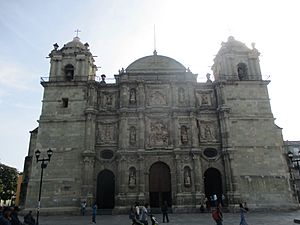
The Oaxaca Cathedral, also known as Cathedral of Our Lady of the Assumption, is the third church built on this spot. The first two were destroyed by earthquakes. Construction of this third church began in 1702 and it was finished in 1733. Its front is made of the green stone common in Oaxaca. Inside, it has a Neoclassical style. The main altar features a bronze statue of Our Lady of the Assumption.
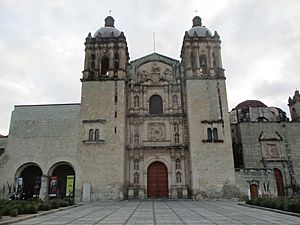
The church and former monastery of Santo Domingo de Guzmán is four blocks north of the cathedral. It was built between 1555 and 1666. The church has a Renaissance-style front. After a period of conflict around 1860, the church was used as a stable, which damaged it. It was later returned to religious use. The monastery part was used as army barracks. In 1994, work began to turn this area into the Centro Cultural Santo Domingo.
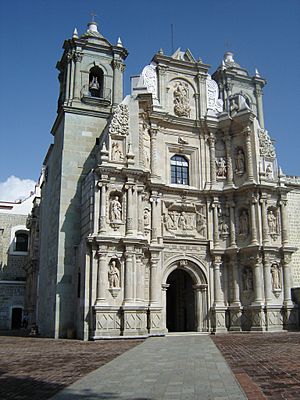
The Basílica de Nuestra Señora de la Soledad is four blocks west of the cathedral. It was built between 1682 and 1697. Its style is Baroque, and its front is made of reddish stone carved to look like a folding screen. Behind the church is the Museo de la Basilica de Nuestra Señora de La Soledad. This museum displays the Virgin's dresses and other items. The statue of the Virgin of Solitude has a 2-kilogram solid gold crown with diamonds. The old monastery building now serves as the Municipal Palace.
The Church and former monastery of Del Carmen Alto belonged to the Carmelites. It started as a small chapel built over an ancient Aztec temple.
The Church and former monastery of St John of God is Oaxaca's oldest church still standing, completed in 1703. This is where the first mass in Oaxaca was held in 1521.
The Church of San Felipe Neri is a great example of Baroque style from the late 1700s. It has a large, golden main altar. Benito Juárez married Margarita Maza here in 1841.
The Ex monastery of San Catalina was built in the mid-1500s. In 1862, it became a jail. Since 1976, it has been a hotel called Hotel Camino Real.
The Church of the Company of Jesus was built by the Jesuits in 1579. Its towers were destroyed by earthquakes and never rebuilt. Inside, a chapel has a statue of the Virgin of Guadalupe. A prayer written in Spanish, English, Náhuatl, and 12 other local languages is displayed there.
Museums and Art Spaces
The Centro Cultural de Santo Domingo is in the old monastery buildings next to Santo Domingo church. It was beautifully restored in 1996. Important artifacts from Monte Albán are displayed here. The Museo de las Culturas de Oaxaca (Museum of Oaxacan Cultures) is a big part of this center. It focuses on Zapotec and Mixtec cultures. One special exhibit is the "Tesoro Mixteco" (Mixtec Treasure). This is a collection of gold and silver jewelry found in Tomb 7 of Monte Albán. It's the richest collection of ancient Mexican gold and silver work.
The Museum of Contemporary Art (Museo de Arte Contemporaneo de Oaxaca, MACO) is in a very old building called Casa de Cortés. It's one of the oldest non-religious buildings in the city. The museum's collection includes works by famous artists like Rufino Tamayo and Francisco Toledo.
The Museo de los Pintores Oaxaqueños (Museum of Oaxacan Painters) is in an 18th-century mansion. It shows the work of local artists like Rodolfo Morales.
The Casa de Culturas Oaxaqueñas used to be a church and monastery from the 1700s. Today, it houses the Instituto Oaxaqueño de la Culturas, which promotes culture and arts in the state.
The Rufino Tamayo Museum (Museo Rufino Tamayo) has a large collection of ancient art that the painter Rufino Tamayo collected himself. He gave this collection and the house to his home state of Oaxaca in 1974. The museum shows over 1150 pieces from different ancient Mexican periods. These include Mayan statues, ceramic dogs, and stone faces.
The Religious Museum of the Ex monastery of La Soledad is next to the Basilica of la Soledad. It displays religious paintings, sculptures, and clothing.
The Instituto de Artes Gráficos de Oaxaca (Graphic Arts Institute of Oaxaca) has a big collection of graphic designs from the past and present.
The Casa de Juárez is a museum about the life of Benito Juárez. He lived here from 1818 to 1828. The museum has documents from his time as president and furniture that shows what homes looked like back then.
The Hemeroteca Publica de Oaxaca "Nestor Sánchez" (Nestor Sanchez Public Newspaper Library of Oaxaca) is behind the former convent of Santo Domingo. Next to it is the Jardin Ethobotánico (Ethnobotanic Garden). These two areas used to be the gardens of the Santo Domingo convent.
The Teatro Macedonio Alcalá is a working theater that also has a collection of romantic art. It was built between 1903 and 1909. It was renamed in 1932 to honor Macedonio Alcalá, who composed the state anthem "Dios Nunca Muere" (God Never Dies). The theater has a grand entrance, a main hall, and a stage.
Other interesting cultural places include the Alvarez Bravo Photography Center, the Oaxaca Stamp Museum, and the Railway Museum of Southern Mexico.
Monte Albán: An Ancient Zapotec City
Monte Albán is an ancient city built by the Zapotecs. It was their capital and was very important between 500 BCE and 800 CE, with about 35,000 people living there. Monte Albán is famous for its buildings, carved stones, and ceramic pots. In 1987, it was named a World Heritage Site, along with the city of Oaxaca.
Local Markets: A Taste of Oaxaca
The Benito Juárez Market is just one block south of the Zócalo. It sells flowers, fruits, ice cream, drinks, crafts, leather goods, and more. The market next to it, the Mercado 20 de Noviembre, is often called the "Mercado de la Comida" (food market). This is because it's full of food stands. It's a great place to try Oaxacan dishes like:
- Moles (complex sauces)
- Tasajo (grilled beef)
- Tlayudas (large, crispy tortillas)
- Pan de yema (a type of egg bread)
- Chapulines (fried grasshoppers with chili)
- Oaxaca cheese (called "quesillo" locally)
- Hot chocolate spiced with cinnamon and almonds.
Parks and Gardens: Green Spaces in the City
Oaxaca has many parks, gardens, and plazas. Many of these used to be part of old monasteries. For example, the Jardín Etnobotánico de Oaxaca surrounds the former Santo Domingo monastery.
The Plaza de la Danza and Jardín Sócrates are also well-known. The Plaza de la Danza was built in 1959 for the annual Bani-Stui-Gulal dance, which happens before the Guelaguetza festival. This plaza also hosts art shows and concerts. The Socrates Garden used to be the front yard of the Basilica de la Soledad. It became a public park in 1881.
The Cerro de Fortín hill nearby has a famous quote by Benito Juárez carved in stone: "El respeto al derecho ajeno es la paz" (Respect for others' rights is peace). The Antonia Labastida Garden is named after a woman who fought alongside Porfirio Díaz. This park is a popular spot for artists and craftspeople to show their work.
Oaxaca's Lively Festivals and Traditions
Guelaguetza: A Celebration of Oaxacan Culture
The Guelaguetza is the biggest cultural event in Oaxaca. It's also known as the Fiestas de los Lunes del Cerro (Festivals of Mondays at the Hill). Its roots go back to ancient times. The "Hill" is the Cerro del Fortín, where ancient rituals were held for the goddess Centeōtl, the goddess of corn.
After the Spanish arrived, they stopped these ancient rituals. The local people then started celebrating the Virgin Mary in the same spot. Over time, this festival grew to be the most important event in the city. In 1932, Oaxaca celebrated its 400th anniversary. They combined these celebrations with the Cerro del Fortín festivities. They added traditional dances, music, regional food, and even a "Miss Oaxaca" pageant.
The word "guelaguetza" comes from the Zapotec language. It means offering, kindness, caring, and cooperation. The first Guelaguetza was so popular that it became an annual event. Since 1953, it has been held every July on the Mondays at the Cerro del Fortín. It brings together festivals from many parts of Oaxaca state.
Today, many Guelaguetza events take place at the Guelaguetza Auditorium. This is a large outdoor theater that can seat 11,400 people. Other events include regional bands playing at the Church of Santo Domingo de Guzmán. They march to the Oaxaca Cathedral, where folk dance groups join them. Another big event is a beauty pageant for indigenous women from different regions of Oaxaca. The winner represents the goddess Centeótl and leads the festivities. The Bamo-Stui-Gulal at the Plaza de la Danza tells the history of Oaxaca. On the city streets, you can see parades with children and giant papier-mâché puppets.
Noche de Rábanos: The Night of the Radishes
The "Noche de Rábanos" or Night of the Radishes is a unique tradition in Oaxaca. On December 23rd each year, artists create amazing designs from large radishes. They often decorate them with other plants. The event only lasts a few hours but draws huge crowds to the main square.
This tradition started from a Dominican Christmas custom. Monks would have a big dinner on December 23rd. To decorate their tables, indigenous servants would carve radishes and add flowers. This led to December 23rd being known as the Night of the Radishes. Today, it's a major cultural event sponsored by the city. There's also a competition where radish creations are judged for their originality and beauty.
Donají: A Zapotec Legend
Donají was a high-ranking Zapotec woman from ancient Mitla. A seer predicted she would die for her country. When she grew up, the Zapotec were at war with the Mixtec. Donají took care of a wounded Mixtec prince named Nucano. She later helped him escape. The war continued, and the Zapotec king and Donají had to leave their capital, Zaachila. During peace talks, the Mixtec didn't trust the Zapotec king, so they took Donají as a hostage.
This happened during the Spanish conquest. Donají asked to be baptized and was renamed Doña Juana de Cortés. As the Mixtec feared, the Zapotec broke the peace treaty and attacked Monte Albán. The Mixtec survivors then killed Donají. Her body was later found in the Atoyac River. Years later, a shepherd found a fragrant lily growing where she was buried. The flower stayed fresh, as if a mysterious force protected it. Donají is honored on the coat of arms of Oaxaca. Her story is also performed every year at the Guelaguetza festival.
Cinema in Oaxaca
For many years, Oaxaca hosted the Oaxaca FilmFest every fall. However, this festival was permanently canceled in 2022.
Delicious Food and Drink in Oaxaca
Oaxaca is known as "Mexico's culinary capital." One of the most famous parts of Oaxacan food is its variety of moles. Moles are complex sauces with roots in Spanish and Arabic cooking. After the Spanish conquest, new ingredients like different chilies, tomatoes, peanuts, and chocolate were added. While moles are found across Mexico, Oaxaca has the most types, including:
- Negro (black)
- Colorado (red)
- Coloradito (faint red)
- Chichilo
- Verde (green)
- Amarillo (yellow)
- Manchamanteles (meaning 'tablecloth stainer').
You can buy moles as a paste in markets. You then mix it with water and simmer it with meat.
Other popular foods in the markets include chocolate bars (used for hot chocolate), traditional breads, and chapulines (fried grasshoppers with chili). Street foods include tlayudas. These are large, slightly crispy corn tortillas topped with ingredients like grilled beef (tasajo), cheese, tomatoes, and avocados.
Local drinks include flavored waters made with sugar and fruits like chilacayota and guanábana. An ancient indigenous drink called tejate is still made and sold in nearby towns like Tlacolula and Ejutla. It's known as the "drink of the gods" and is made with corn, cacao, cacao flower, and mamey fruit seeds. For alcoholic drinks, mezcal is popular. Like tequila, mezcal is made from the agave plant, but it can use different types of agave.
Chocolate has been very important in Oaxaca since before the Spanish conquest. Besides being food, it was also used as medicine, and cacao seeds were even used as money. Oaxaca's chocolate is famous in Mexico. It's flavored with cinnamon, almonds, and sugar. It's usually prepared with hot water or milk and served with a local sweet roll.
Famous People from Oaxaca
- Benito Juárez, former president of Mexico
- Porfirio Díaz, former president of Mexico
- José Vasconcelos, writer and philosopher
- Ricardo Flores Magón, anarchist and social reformer
- Rodolfo Morales, artist
- Rufino Tamayo, artist
- Francisco Toledo, artist
- Lila Downs, singer
- Vinny Castilla, Major League Baseball player
- Gerónimo Gil, Major League Baseball player
- Macedonio Alcalá, composer
- Nadia Yvonne López Ayuso, singer
- María Sabina, shaman
- Carlos María de Bustamante, statesman
- Susana Harp, singer
- Alejandra Robles, singer & dancer
Education in Oaxaca
Oaxaca city is home to several universities. The Universidad Autónoma Benito Juárez de Oaxaca has buildings across the city. Its most noticeable building is the Edificio Central de la Universidad (Central Building of the University). It's in the historic downtown and was built between 1899 and 1901. Its style is European Romantic, but it also has local touches. This building houses the Department of Law and Social Studies.
Other universities in the city include the Universidad de Mesoamérica and the Universidad Anáhuac Oaxaca, which opened in 2000.
Getting Around: Transportation in Oaxaca
Oaxaca-Xoxocotlan Airport (OAX) is about 7 kilometers south of the city center. Most flights go to Mexico City for connecting flights. There are also flights to other Mexican cities like Huatulco, Cancún, and Tijuana. Plus, American Airlines and United Airlines offer direct flights between Oaxaca and their U.S. hubs in Dallas and Houston.
The city has separate bus stations for different types of buses. You can find buses to most places within Oaxaca state, including coastal resorts like Huatulco and Puerto Escondido. There are also long-distance buses to Puebla, Mexico City, and Veracruz. TUSUG is the largest bus company in Oaxaca.
Major highways serving Oaxaca include Federal Highways 175 and 131 (south to the coast) and National Highways 190 and 125 (southwest). The autopista 150D/131D offers a faster route to Mexico City.
Surrounding Towns: Craft and Culture
Many small towns surround Oaxaca city. They are closely connected to the city, especially through their crafts. These towns are known for making specific crafts that represent the three central valleys of Oaxaca. You can visit workshops in these towns to see how crafts are made traditionally, even though most products are sold in the main city.
- Santa María Atzompa makes glazed pottery with green glass.
- San Antonio Arrazola and San Martín Tilcajete create alebrijes, which are small, painted wooden figures.
- San Bartolo Coyotepec is famous for its barro negro pottery (black clay pottery).
- Teotitlán del Valle weaves wool to make tapestries and rugs. These rugs are known for their bright colors and geometric designs, often made with natural dyes. For example, a wild marigold called pericon gives a golden yellow, cochineal insects give reds, and indigo plants give blues.
Oaxaca city and its surrounding towns also have special market days. On these days, you can visit tianguis (open-air markets).
- Mondays in Miahuatlán are for buying daily goods.
- Tuesdays in Ayoquezco are known for wood furniture.
- Wednesdays in Etla and Zimatlán are great for dairy products, especially cheese.
- Thursdays have the two largest tianguis in Ejutla and Villa de Zaachila.
- On Fridays, in Coyotepec, Jalietza, and Ocotlán, you can find cotton textiles, embroidered blouses, corn-husk flowers, and glazed pottery.
- Saturdays are for the main city of Oaxaca.
- Sundays in Tlacolula are for buying mezcal.
Oaxaca Municipality: The Larger Area
The city of Oaxaca is the main center for the Municipality of Oaxaca. This municipality includes the city and several smaller communities like Arbolada Ilusión, Camino Ancho, and Guadalupe Victoria. The total area of the municipality is about 85.48 square kilometers (33 square miles). As of 2021, around 715,000 people live in or near the city of Oaxaca.
While Spanish is the most common language, about 20,109 people spoke an indigenous language in 2005. This shows that many different ethnic groups still live in the municipality.
The municipality is located in the Valley of Oaxaca, surrounded by the Sierra Madre del Sur mountains. It's about 1550 meters (5000 feet) high. The area is known as the "Valles Centrales" (Central Valleys) region and has thick forests of pine and oak trees.
Sister Cities of Oaxaca
Oaxaca has special connections with other cities around the world:
| Town | State/Region | Country |
|---|---|---|
| Antequera | Andalusia | Spain |
| Palo Alto | California | United States |
See also
 In Spanish: Oaxaca de Juárez para niños
In Spanish: Oaxaca de Juárez para niños


